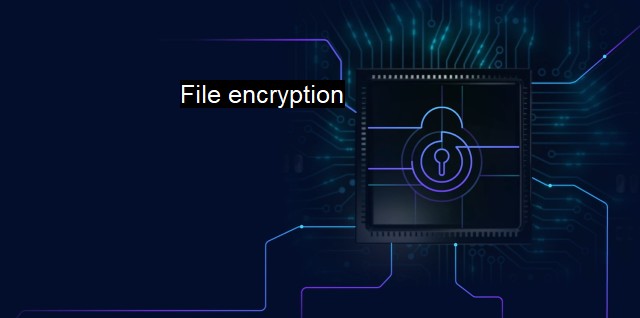What is File encryption?
File Encryption: The Ultimate Defensive Tool for Cybersecurity and Data Protection
File encryption is an essential element in the realm of cybersecurity and antivirus protection, ensuring data privacy and system integrity. This basic function secures digital content by making it unreadable to anyone who is unauthorized to access it. Using complex algorithms to hide information from unknown entities, file encryption offers a protective guard against cyber attacks or damages that might disrupt an individual or organization's functioning.When a file is encrypted, the data within it is transformed into forms that are unreadable unless a cryptography key has been deployed. This key could either be a password known only to the authorized users, or a digital key which can be automatically authenticated by relevant applications. Once the correct key is provided, the gibberish of the encrypted file is turned into legible data again, ensuring secured transmission or storage of data.
Encryption programs often operate on the binary data inside the file, converting it into another set of data. This set, confusingly meaningless to unauthorized users, makes the data secure. The algorithms used in generating this obscured data can range from simple mathematical functions to complex calculations that rely on very large "prime numbers" – the sheer complexity of their fundamental operations makes cracking them improbable.
The breadth of file encryption utilities is vast. They protect personal data on our phones and laptops from falling into the wrong hands if the devices are lost or stolen; the highly sensitive data used by intelligence and law enforcement agencies; and critical project files, financial documents, and client details used in businesses. They can be employed to secure both stored data and transferred data against cyber intruders. all communication over the internet, be it to conduct financial transfers or social networking, employs various encryption processes to ensure safety.
A common instance is the Secure Sockets Layer encryption that is used online to keep data transmitted over a network secure. Websites that employ SSL encryption for data sent between the user and server indicate this by using the 'https' protocol. Both the commercial and privacy-seeking arms of the internet employ such encryption practices.
During file transmission, encryption protects data from being intercepted and represents a critical defense mechanism against cyberattacks. Without encryption, transferred data could easily be intercepted and read by anyone with some reasonable know-how. It's akin to sending a postcard - unless it's in an envelope (encrypted), anyone who handles it can read what's written.
Antivirus protection has traditionally been the first line of defense against harmful software attacks intent on damaging systems and stealing information. Adding file encryption into the mix increases the level of security significantly. If in the worst-case scenario, malware or virus does breach the antivirus defenses and infiltrates a system, they will be met with encrypted files that are unreadable without the correct key.
Encryption has self-preserving attributes. If an encrypted file is infiltrated, the damage may be limited only to that file, protecting the rest of the system's data. The breached segment would remain illegible to the attacker, and the attack's impact could swiftly be minimised.
Given its importance in the digital landscape, file encryption has been integrated into most operating systems. End-to-end encryption, for instance, is a popular feature in several messaging platforms, such as WhatsApp, ensuring that only the sender and receiver can read the messages – nobody else, not even the platform itself.
Undoubtedly, file encryption is not completely impregnable – cybersecurity has been tasked with perpetually developing increasingly sophisticated algorithms and defenses to keep pace with those seeking to disrupt them. the utilization of file encryption as a foundational method is a substantial step towards ensuring stronger data privacy and cybersecurity, making it a powerful shield in the face of ever-evolving internet threats.

File encryption FAQs
What is file encryption?
File encryption is the process of converting a plaintext file into an encoded version that can only be read by someone who has the appropriate decryption key or password. This method is often used in cybersecurity to protect sensitive data from being accessed by unauthorized individuals.How does file encryption enhance cybersecurity?
File encryption enhances cybersecurity by providing an extra layer of protection for sensitive data. If encrypted files are intercepted by hackers or cybercriminals, they will not be able to read or access the information unless they have the decryption key or password. Thus, file encryption helps to prevent data breaches and unauthorized access to sensitive information.What are some common types of file encryption?
Some common types of file encryption include symmetric-key encryption, asymmetric-key encryption, and hashing. Symmetric-key encryption uses a single key to both encrypt and decrypt the file, while asymmetric-key encryption uses two different keys for these processes. Hashing is a process of converting a file into a unique, fixed-length code that cannot be reversed.Is file encryption compatible with antivirus programs?
Yes, file encryption is compatible with antivirus programs. However, encrypted files cannot be scanned for malware or viruses because their contents are unreadable. Therefore, it's important to ensure that your antivirus program is up-to-date and capable of detecting malware before encrypting your files.| | A | | | B | | | C | | | D | | | E | | | F | | | G | | | H | | | I | | | J | | | K | | | L | | | M | |
| | N | | | O | | | P | | | Q | | | R | | | S | | | T | | | U | | | V | | | W | | | X | | | Y | | | Z | |
| | 1 | | | 2 | | | 3 | | | 4 | | | 7 | | | 8 | | |||||||